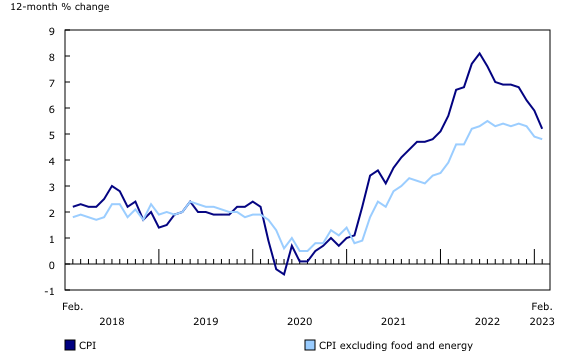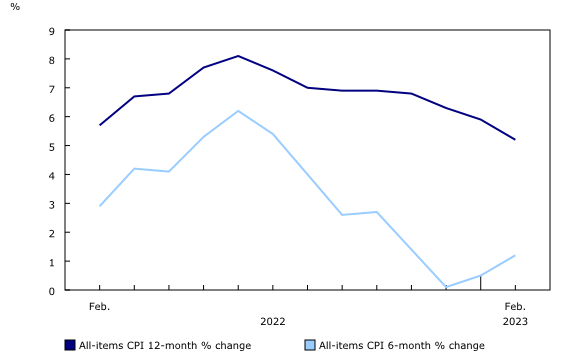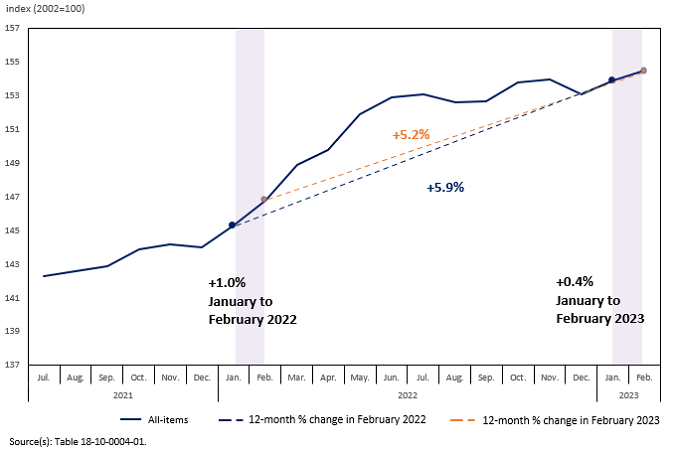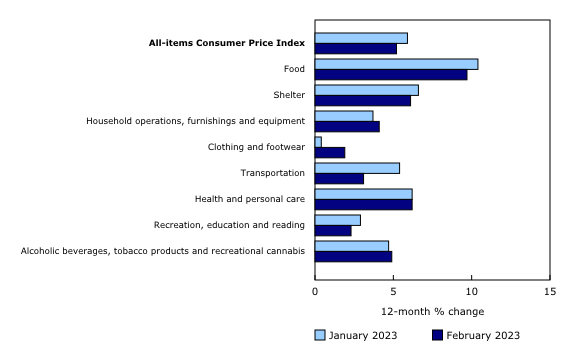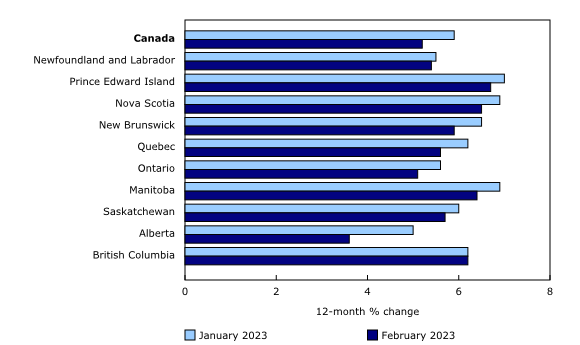Consumer Price Index, February 2023
Released: 2023-03-21
February 2023
5.2% 
(12-month change)
The Consumer Price Index (CPI) rose 5.2% year over year in February, following a 5.9% increase in January. This was the largest deceleration in the headline CPI since April 2020.
The year-over-year deceleration in February 2023 was due to a base-year effect, for the second consecutive month, which is attributable to a steep monthly increase in prices in February 2022 (+1.0%).
Excluding food and energy, prices were up 4.8% year over year in February 2023, following a 4.9% gain in January, while the all-items excluding mortgage interest cost rose 4.7%, after increasing 5.4% in January.
On a monthly basis, the CPI was up 0.4% in February, following a 0.5% gain in January. Compared with January, Canadians paid more in mortgage interest costs in February, which was partially offset by a decline in energy prices. On a seasonally adjusted monthly basis, the CPI rose 0.1%.
While inflation has slowed in recent months, having increased 1.2% compared with 6 months ago, prices remain elevated. Compared with 18 months ago, for example, inflation has increased 8.3%.
Base-year effects and the headline Consumer Price Index
The Consumer Price Index (CPI) is a standard measure of the price of a representative basket of goods and services. The headline consumer inflation is measured as the percentage change between the CPI in the current month (February 2023) and the CPI in a base month or the same calendar month of the previous year (February 2022).
A base-year effect refers to the impact that price movements from 12 months earlier have on the current month's headline consumer inflation. When a large 1-month upward price change in the base month stops influencing or falls out of the 12-month price movement, this has a downward effect on headline CPI in the current month. Conversely, a large 1-month downward price change in the base month creates upward pressure on the current month's 12-month figure.
In the first half of 2022, the global economy was significantly affected by the Russian invasion of Ukraine, and Canadian consumers experienced a significant increase in prices from January to June 2022. Headline consumer inflation increased from 5.1% in January to 8.1% in June 2022. The broad increase in prices in the early months of 2022, led by energy products, had a downward impact on the year-over-year rate of consumer inflation in February 2023, because higher prices from February 2022 were used as the basis for year-over-year comparison.
Price increases observed in the first half of 2022 will continue to fall out of the 12-month price movement. While inflation has slowed in recent months, prices remain elevated. Users should consider the impact of base-year effects when interpreting the 12-month price movement.
Grocery prices remain elevated
Food purchased from stores rose 10.6% year over year in February, marking the seventh consecutive month of double-digit increases. Continuing to put upward pressure on grocery prices are supply constraints amid unfavourable weather in growing regions, as well as higher input costs such as animal feed, energy and packaging materials.
Price growth for some food items such as cereal products (+14.8%), sugar and confectionary (+6.0%) and fish, seafood and other marine products (+7.4%) accelerated on a year-over-year basis in February.
Prices for fruit juices were up 15.7% year over year in February, following a 5.2% gain in January. The increase was led by higher prices for orange juice, as the supply of oranges has been impacted by citrus greening disease and climate-related events, such as Hurricane Ian.
In contrast, price growth for other food items slowed, on a year-over-year basis in February compared with January, including non-alcoholic beverages (+11.1%), meat (+6.2%), vegetables and vegetable preparations (+13.9%) and bakery products (+13.9%).
Prices for dairy products also rose to a lesser extent on a year-over-year basis in February (+9.1%) compared with January (+12.4%), partially due to a base-year effect. The slowdown stemmed from higher prices in February 2022, when the Canadian Dairy Commission increased the price that processors paid farmers, the largest price increase on record.
Energy prices fall on greater supply
In February, energy prices fell 0.6% year over year, following a 5.4% increase in January. Gasoline prices (-4.7%) led the drop, the first yearly decline since January 2021. The year-over-year decrease in gasoline prices is partly the result of a base-year effect, as prices began to rise rapidly in the early months of 2022 during the Russian invasion of Ukraine.
On a monthly basis, Canadian drivers paid 1.0% less for gasoline in February amid higher crude oil inventory levels within the United States.
Prices for fuel oil and other fuels rose at a slower pace year over year in February (+24.3%) compared with January (+36.5%).
Shelter costs increase at a slower pace for the third consecutive month
Shelter costs rose at a slower pace year-over-year for the third consecutive month, rising 6.1% in February, after an increase of 6.6% in January. The homeowners' replacement cost index, which is related to the price of new homes, slowed on a year-over-year basis in February (+3.3%) compared with January (+4.3%). Other owned accommodation expenses (+0.2%), which includes commissions on the sale of real estate, also decelerated in February. These movements reflect a general cooling of the housing market.
Conversely, the mortgage interest cost index increased at a faster rate year over year in February (+23.9%) compared with January (+21.2%), the fastest pace since July 1982. The increase occurred amid a higher interest rate environment.
Explore the Consumer Price Index tools
Check out the Personal Inflation Calculator. This interactive calculator allows you to enter dollar amounts in the common expense categories to produce a personalized inflation rate, which you can compare to the official measure of inflation for the average Canadian household—the Consumer Price Index (CPI).
Visit the Consumer Price Index portal to find all CPI data, publications, interactive tools, and announcements highlighting new products and upcoming changes to the CPI in one convenient location.
Browse the Consumer Price Index Data Visualization Tool to access current (Latest Snapshot of the CPI) and historical (Price trends: 1914 to today) CPI data in a customizable visual format.
Find the answers to the most common questions about the CPI in the context of the COVID-19 pandemic and beyond.
Regional highlights
Year over year, prices rose at a slower pace in February compared with January in nine provinces. Prices in British Columbia were unchanged compared with January, with lower energy prices offset by higher prices for rent (+8.1%).
Price growth slows the most in Alberta
Among the provinces, price growth in Alberta (+3.6%) slowed the most, on a year-over-year basis, in February. Much of this slowdown resulted from lower energy prices, notably for gasoline (-13.3%) and natural gas (-10.4%).
Child care and housekeeping services (-33.8%) also contributed to the year-over-year deceleration in Alberta in February, due to a federal-provincial agreement, as part of a national plan to reduce child care costs. At the national level, prices were down 14.2% compared with February 2022.
Note to readers
New approach to estimating the sub-indices of the digital computing equipment and devices index
The computer equipment, software and supplies index and the multipurpose digital devices index, which are sub-indices of the digital computing equipment and devices index, are now updated with an enhanced methodology and new data sources. A technical paper describing the new approach is available, Measuring the price of digital computing equipment and devices in the Consumer Price Index.
Consumer Price Index basket update in June 2023
The Consumer Price Index (CPI) is based on a fixed basket of goods and services designed according to international standards and methods. On June 20, 2023, updated basket weights for the goods and services used in the calculation of the CPI will be made available in table 18-10-0007-01. The new basket weight reference period will be 2022, based on the most recent household final consumption expenditure data and other alternative data. The methods and data sources used will be similar to the last basket update in June 2022.
One week later, on June 27, the May 2023 CPI will be released, based on the updated basket weights.
For general information on basket updates, consult The Canadian Consumer Price Index Reference Paper, chapter 8, "Weights and basket updates."
Real-time data tables
Real-time data table 18-10-0259-01 will be updated on April 3. For more information, consult the document "Real-time data tables."
Next release
The CPI for March will be released on April 18.
Products
The "Consumer Price Index Data Visualization Tool" is available on the Statistics Canada website.
More information on the concepts and use of the Consumer Price Index (CPI) is available in The Canadian Consumer Price Index Reference Paper (62-553-X).
For information on the history of the CPI in Canada, consult the publication Exploring the First Century of Canada's Consumer Price Index (62-604-X).
Two videos, "An Overview of Canada's Consumer Price Index (CPI)" and "The Consumer Price Index and Your Experience of Price Change," are available on Statistics Canada's YouTube channel.
Find out answers to the most common questions posed about the CPI in the context of COVID-19 and beyond.
Contact information
For more information, or to enquire about the concepts, methods or data quality of this release, contact us (toll-free 1-800-263-1136; 514-283-8300; infostats@statcan.gc.ca) or Media Relations (statcan.mediahotline-ligneinfomedias.statcan@statcan.gc.ca).
- Date modified:

